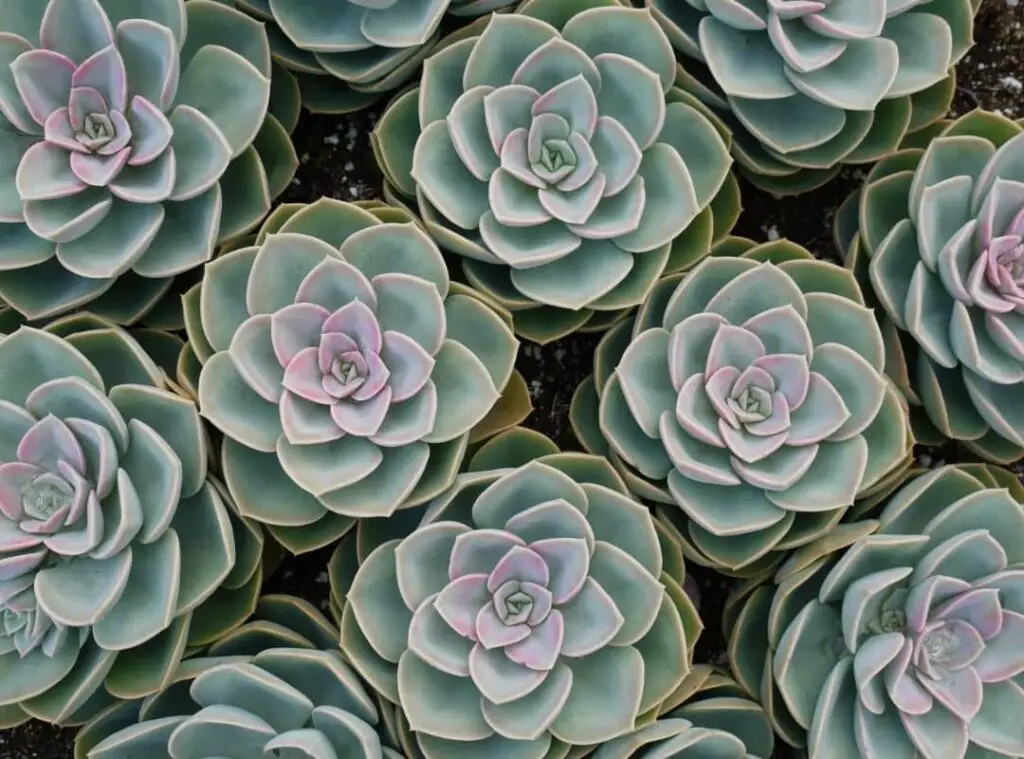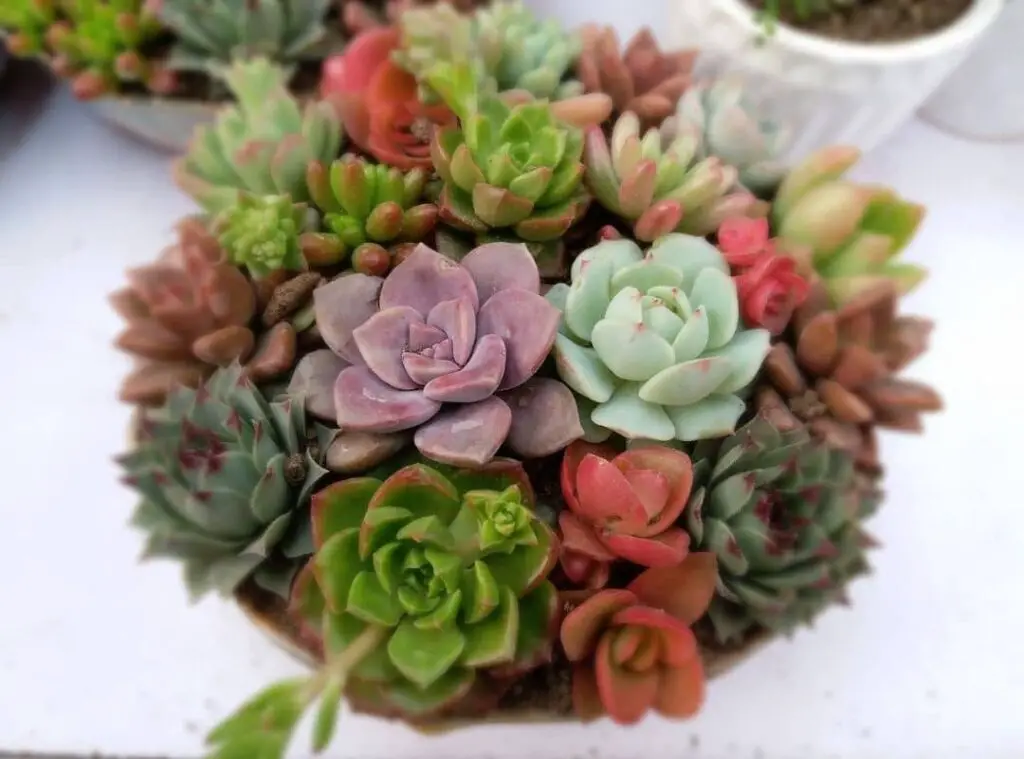Succulents in general are opportunist growers and they will grow well if they get the right growing conditions and slow their growth rate once the growing conditions get adverse. This article is an in depth guide about those winter dormant succulents and summer dormant succulents.

What happens when a plant goes dormant?
Succulents stop growing when they are dormant. Further they conserve their energy for future purposes until they get healthy weather conditions when they are dormant.
This is a natural process which takes place due to weather changes. However, you can control it artificially when you ship them or when you are trying to make them bloom during a certain time.
Succulents do not grow at the same phase during the whole year. When there are fluctuations in temperatures , either they would grow slowly, or they would grow actively.
When a plant goes dormant, you should change the way you look after them accordingly. Dormancy has a close relationship with the weather. Hence, Categorizing the plants as winter growers and summer growers could be effective here.
Dormancy period
Dormancy is the period when the succulents halt their growth and rest of their physical growth. Dormancy is benefitted from conditions such as extreme temperature, dryness etc.
Once a succulent reaches its dormancy. Depending on temperature different succulents will grow at different growth rates.
There could be some succulents which could go dormant and slow their growth rate when there are hot weather conditions or when there is colder weather.
Hence why you could call the succulents as opportunist growers. However, the majority of the succulents prefer to grow in temperate weather particularly during spring and fall.
You can categorize succulents into two categories, and they are winter growers and summer growers. Summer growing succulents grow well during hot summer and reach into dormancy during colder times.
On the other hand, winter growers are what grow well during winter from November to February and which halt growing temporarily in summer.
Usually, you should refrain from repotting when they are dormant as they are literally in sleeping mode and you should avoid disturbing them.
How do I know if my succulent is dormant?
If you could spot, your plants stop in forming the new growth entirely, it means the plants are dormant.
Besides, if the plant’s leaves have turned yellow or brown or if the leaves are hanging around the succulent stem, that literally means the plants are in their dormancy too.
Further chances are that some rosette succulents’ rosettes may also contract too. Furthermore, you can use a snap scratch test to know if your succulent is dormant too.
Different succulents may go dormant at different temperatures as it would depend on the succulent species. For example, sempervivums are cold hardy plants as they can withstand the frost.
However, they will go into dormancy below freezing temperatures. On the other hand, if we consider Echeverias , they are more tender and they can go dormant at higher levels of temperatures.
If you wish to use the snap scratch test, you can simply pick a small branch and try to bend it. If you can bend the branch easily, that literally means the plant is dead.
You will see how dry the inside of it is too. If the succulent you have is a healthy one, you cannot bend it easily and you will spot the fleshy green inside.
If your succulent does not have any branch, you can simply scratch the stem and see. If it is healthy, it would be green and moist underneath.
Besides, you can check its roots to see whether they are dormant too. If the plant seems to be dead, you can take out the plant from the pot and see whether the roots are healthy. If the roots are healthy, it literally means the plant is in dormancy.

Winter dormant succulent
As aforesaid, succulents are divided into two different categories such as winter dormant and summer dormant succulents.
Winter dormant succulents will grow actively in spring , summer and in fall. Having said that, winter dormant succulents will reach into mini dormancy during the hottest days of summer in months such as July and August and they would slow down the growth.
Despite the fact that they prefer warmer conditions, they would not prefer to be exposed to extreme heat as it would be unhealthy for them.
They will slow down their growth during temperatures below 40 degrees Fahrenheit. Further, do not over water them when they are dormant at any given time.
Summer dormant succulents
Summer dormant succulents grow well if they get colder temperature conditions. They will usually grow well during fall, winter, and spring.
However, summer dormant succulents will go into mini dormancy during December and January. Ensure that you are protecting these plants from extreme heat.
They would want a limited amount of water to thrive during summer. They would usually prefer to have a temperature below 60 degrees Fahrenheit at night and a little warmer temperature during the rest of the day.
Succulents’ dormancy table

How do I know if my succulents are summer or winter dormant?
You can identify if your plants are summer dormant or winter dormant by observing the plants’ outlook.
The most significant factor you need to check when a succulent is in dormancy is to check whether they have stopped growing entirely.
If your succulent has plump leaves , they will become yellow or brown. Besides, you can check on the plant’s roots and see whether they are dead or healthy.
If the plants seem to be dead , they would still be healthy and they are just in dormancy.
Do indoor succulents go dormant?
Indoor grown succulents don’t go into a true dormancy. The reason for that is because the indoor grown succulents do not get exposed to drastic fluctuations in the temperature. Hence propagating them or repotting them is not an issue right throughout the year.
Do dormant succulents need sunlight?
Dormant succulents prefer to have full sunlight for about four hours daily and preferably it needs to be indirect sunlight during the rest of the day.
If you grow the succulents as houseplants, you can place them near window sills. It would allow you to grow the plants without any grow lights.
Do you water succulents when they are dormant?
Watering the succulents properly is the most critical thing you need to do when a succulent is in dormancy. When the succulents are dormant, you need to water them less often.
Keep in mind that when a succulent is dormant, they are not trying to grow, instead they will be in relaxing and sleeping mode.
They prefer to be alone and can thrive with minimum water. When you grow the succulents as houseplants, they will keep growing at the same rate and would want you to water them with regular water amounts.
If the soil is bone dry only, you may water the plants. With that being said, the winter dormant succulents would want hardly any water or no water at all.
You need to adjust the watering level by observing how cold the temperature is. Usually, the succulents may not absorb water actively when they have peak temperature particularly during summer as they still want to keep their roots cool.
Besides, they will concentrate more on how to form deeper roots so that they can withstand more intense drought conditions.
However when it comes to winter dormant plants watering, best is to water them at least in less amounts so that they will not be bone dry unless it could even result in the death of the plants.
Can I repot dormant succulents?
If you have grown the succulents as indoor plants, you can repot them without any issue as they do not go through a true dormancy.
In contrast to this, if you need to repot outdoor growing succulents ,you need to wait until they are in their active growing season and then repot them.
Best seasons to conduct repotting would be either Spring or fall as you could reap best results if you conduct propagation during these times.
However, if there is no extreme weather, you can repot them all year long. Succulent can withstand the transplant shock when they are in their actively growing phase. This literally means they can recover in a short period and could thrive well in the new growing conditions as well.

How to transport dormant succulent
If you do not have any restrictions with regard to moving succulents in the pots, you can simply wrap the plants , pot and soil with a couple of layers of newspaper and then pack them.
When you pack them ensure that you pack the large plants on the bottom and smaller and the lightweight plants on the top.
How do you get a plant out of dormancy?
Usually the dormant plants would take weeks to revive from the dormancy in spring.
First thing you need to do to revive a dormant plant is to expose them to indirect sunlight, water them thoroughly and feed them with a half diluted fertilizer.
These conditions would stimulate new growth. You cannot exactly tell when they will come out of dormancy as different succulent species have different relaxing requirements.
However, the majority of succulents need a certain length of colder weather and dormancy before they enter spring.
When you expose them for some sunlight , that will be an indication for the plant to wake up. When you expose them for sunlight, ensure that you do it gradually.
Unless it could be harmful for the plants since the drastic changes in weather could traumatize the plants. Chances are that it could even be lethal on the plants too.
Further water them moderately when they need to start growing up properly. However ensure that there will be no excess water remaining in the pot and all excess moisture is draining from the pots. ‘
Consider feeding them now. If you wish to do so.. However make sure that what you are using is a light dose of fertilizer.
Even when you shift the plants outdoors, you should not expose them for colder temperatures. If it is necessary you can remove the weak growth of the plants so that it would look healthy and fresh.
If you want to transplant the plants, you may do that as well.. When repotting , do it in a fresh well draining soil mix.
Besides, chances are that dormant plants may never revive too. In that case, you need to overwinter the plants and try to wake them up in spring.
Read Next : Why Is Kalanchoe Blossfeldiana Leggy? (Only 1 Answer)
